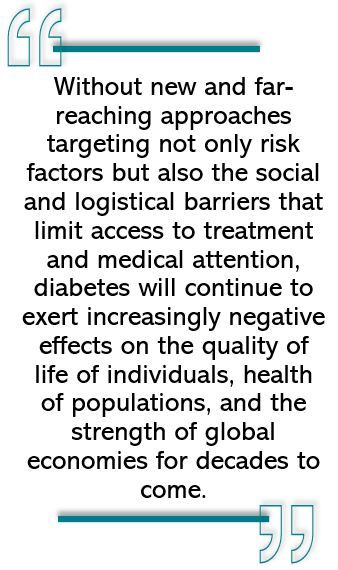- Clinical Technology
- Adult Immunization
- Hepatology
- Pediatric Immunization
- Screening
- Psychiatry
- Allergy
- Women's Health
- Cardiology
- Pediatrics
- Dermatology
- Endocrinology
- Pain Management
- Gastroenterology
- Infectious Disease
- Obesity Medicine
- Rheumatology
- Nephrology
- Neurology
- Pulmonology
Global Diabetes Prevalence Will Double by 2050, Affecting 1.3 Billion People: New Predictions
More than 1.3 billion people will be living with diabetes by 2050, the majority of whom will have type 2 diabetes (T2D). That number reflects a doubling of the estimated 529 million people recorded in 2021 and that number was the result of a global age-standardized increase in prevalence of 90.5% over the previous decade.
The alarming rise, which outpaces global increases in other diseases, is blamed largely on rapid increases in obesity and widening inequities in health care delivery worldwide, according to authors of a new study.
Their predictions published June 22, 2023, in The Lancet, come from an analysis by researchers at the University of Washington School of Medicine’s Institute for Health Metrics and Evaluation (IHME) of data from the most recent Global Burden of Diseases, Injury, and Risk Factors Study (GBD) 2021. The team was led by Liane Ong, lead research scientist at the IHME.
T2D, which accounts for 96% of the global disease burden, is “largely preventable and, in some cases, potentially reversible,” the authors emphasize, and particularly if diagnosed and effectively managed early in the course of the disease. Moreover, strategies to reduce prevalence of T2D are well established, they add, and include limiting risk factors and increasing access to treatment. A primary factor mitigating progress in these areas, however, is the complex of social determinants of health that have led to “considerable disparities across populations in risk factor profiles, access to screening and treatment, and available health services.”
A primary factor mitigating progress in these areas, however, is the complex of social determinants of health that have led to “considerable disparities across populations in risk factor profiles, access to screening and treatment, and available health services.”
The team, which included member of the GBD 2021 Diabetes Collaborators, examined prevalence of and morbidity and mortality related to diabetes for 204 countries and territories between 1990 and 2021. Based on epidemiologic patterns, researchers grouped these into 7 seven super-regions. Ong and colleagues generated estimates for T2D across the lifespan and for women and men, separately and combined, according to the authors. They also quantified the proportion of T2D attributable to 16 selected risk factors to highlight main drivers of the disease.
2050 projections
The IHME/GBD researchers calculated the current global prevalence of diabetes to be 6.1% which makes the disease one of the world’s top 10 leading causes of death and disability. The age-standardized total prevalence is expected to increase to 9.8% by 2050 with the rise driven almost equally by trends in obesity (49.6%) and demographic shifts (50.4%).
When they looked more closely at the 7 super-regions, Ong et al projected prevalence to be higher than 10% by 2050 in North Africa and the Middle East (16.8%) and Latin America and the Caribbean (11.3%). In close to half (43.6%) of the world’s countries and territories, the rate will exceed 10% in 3 decades and is projected to surpass 20% in 11.8% of the world.
“There are no countries and territories where diabetes prevalence rates are expected to decrease,” they wrote.
Diabetes by age. Total diabetes prevalence was more than 20% among people aged 65 and older in every country and peaked at 24.4% among those aged 75 to 79 years. When researchers examined the data by super-region, the highest rate in this age bracket was in North Africa and the Middle East (39.4%) and the lowest in Central Europe, Eastern Europe, and Central Asia (19.8%).
Diabetes by sex. Worldwide, Ong and team found, age-standardized diabetes prevalence was higher in women (6.5%) than in men (5.8%). The authors did report some geographic variation in the male-to-female sex ratio, however, with prevalence 1.4 times higher among men vs women in central sub-Saharan Africa. Of 140 areas where diabetes was found more prevalent in men than women, there were 3 countries where the rate was more than 50% higher than among women—Angola, Uganda, and Gabon.
Risk factors ranked. Of the 16 risk factors for T2D the team analyzed, elevated body mass index was the primary one, accounting for 52.2% of disability-adjusted life years (DALYs). BMI was followed by dietary risks (25.7%), environmental/occupational risks (19.6%), tobacco use (12%), low physical activity (7.4%), and alcohol use (1.8%) of T2D DALYs.

Invesitigators' caution
“The rapid rate at which diabetes is growing is not only alarming but also challenging for every health system in the world, especially given how the disease also increases the risk for ischemic heart disease and stroke,” concluded Ong and colleagues.
“While the general public might believe that T2D is simply associated with obesity, lack of exercise, and a poor diet, preventing and controlling diabetes is quite complex due to a number of factors. That includes someone’s genetics, as well as logistical, social, and financial barriers within a country’s structural system, especially in low- and middle-income countries.
"Without new and far-reaching approaches targeting not only risk factors but also the social and logistical barriers that limit access to treatment and medical attention, diabetes will continue to exert increasingly negative effects on the quality of life of individuals, health of populations, and the strength of global economies for decades to come."
Reference: GBD 2021 Diabetes Collaborators. Global, regional, and national burden of diabetes from 1990 to 2021, with projections of prevalence to 2050: a systematic analysis for the Global Burden of Disease Study 2021. Lancet. Published online June 22, 2023. doi:10.1016/PII
